Faintly rumbling ground and clattering dishes in Whitehorse on July 8 were caused by a tectonic event that began millions of years ago.
Early in the afternoon, some Whitehorse residents felt the quake and took to social media to describe the shaking. It was also picked up on an Earthquakes Canada seismograph.
Taimi Mulder, an earthquake seismologist with the Geological Survey of Canada, said the initial quake was detected at 1:49 p.m. with its epicentre just south of the British Columbia border in Alaska, about 28 kilometre from Pleasant Camp. Its magnitude was measured at a 4.4.
Mulder said the initial quake was followed by a series of more than 10 aftershocks, three of which were magnitude 3 or greater.
Quakes in the area are common and Mulder said one that could be felt in Whitehorse is not unheard of. She said the most recent major event in the area was a pair of magnitude 6.3 quakes on May 1, 2017.
Those quakes disrupted power to over 8,000 residents of the Southern Lakes area and parts of Whitehorse. It also forced the brief evacuation of a Whitehorse office building. Mulder said she heard the story of a hiker in the Tatshenshini-Alsek Park in B.C. who faced a few scary moments as the mountain shook beneath their feet.
The July 8 quake was not nearly as strong as the 2017 tremors, but Mulder said it was caused by the same complex tectonic history. Beneath the Yukon and Southeast Alaska, the Pacific plate of the earth’s crust is subducting, or slowly sliding beneath the North American plate. She said many of the earthquakes in the area are related to this ancient subduction.
Mulder said the crumpling of plates during this subduction is one of the causes of the soaring mountains along the coast. Even before the Pacific plate began to be forced under the North American plate, Mulder said another tectonic feature called the Kula plate subducted beneath Alaska and the Yukon completely between 40 and 60 million years ago.
Contact Jim Elliot at jim.elliot@yukon-news.com
